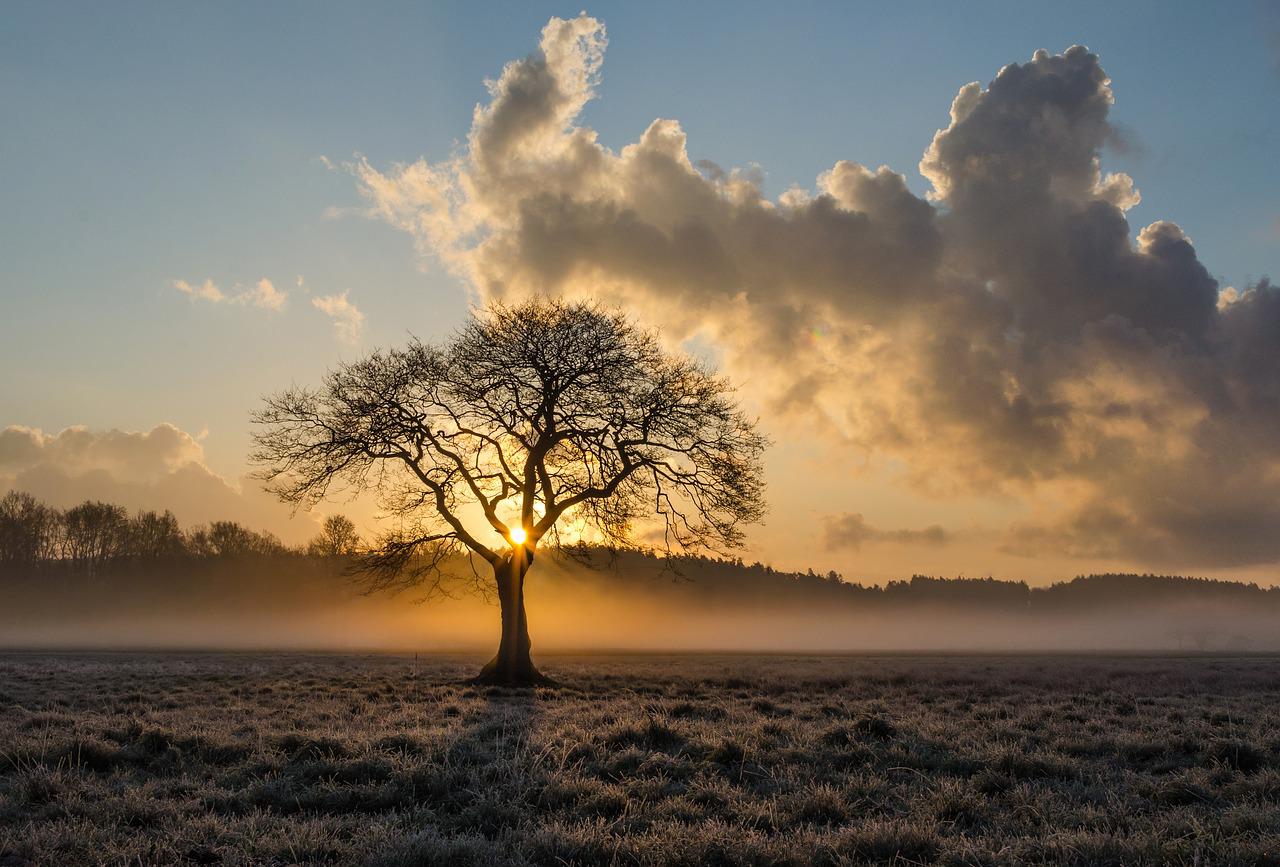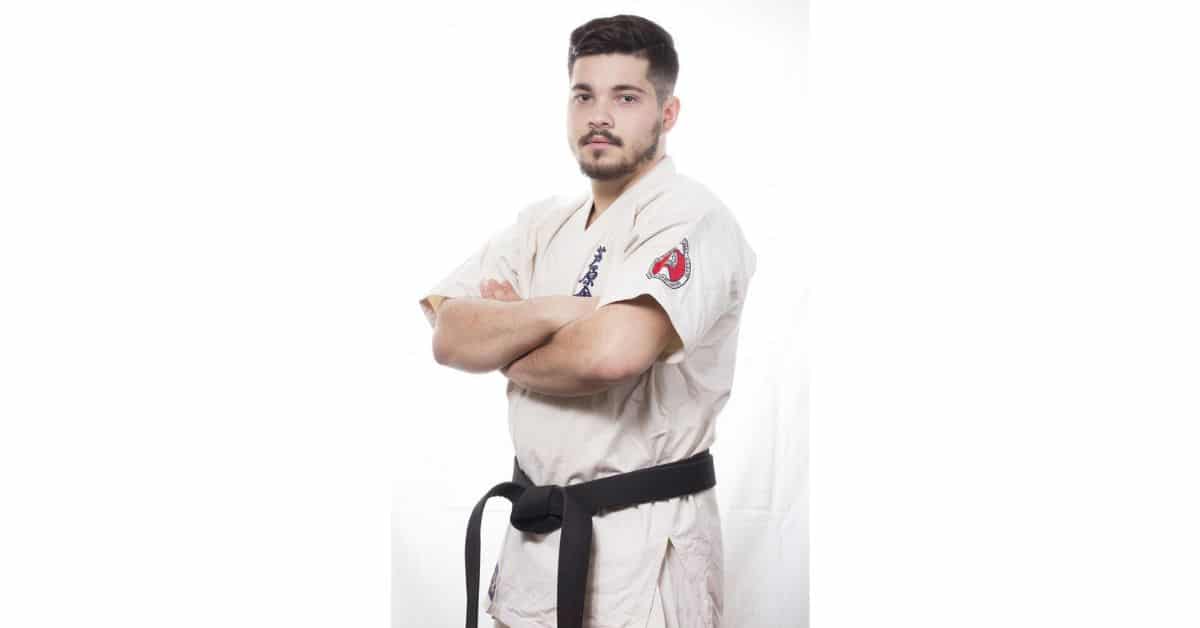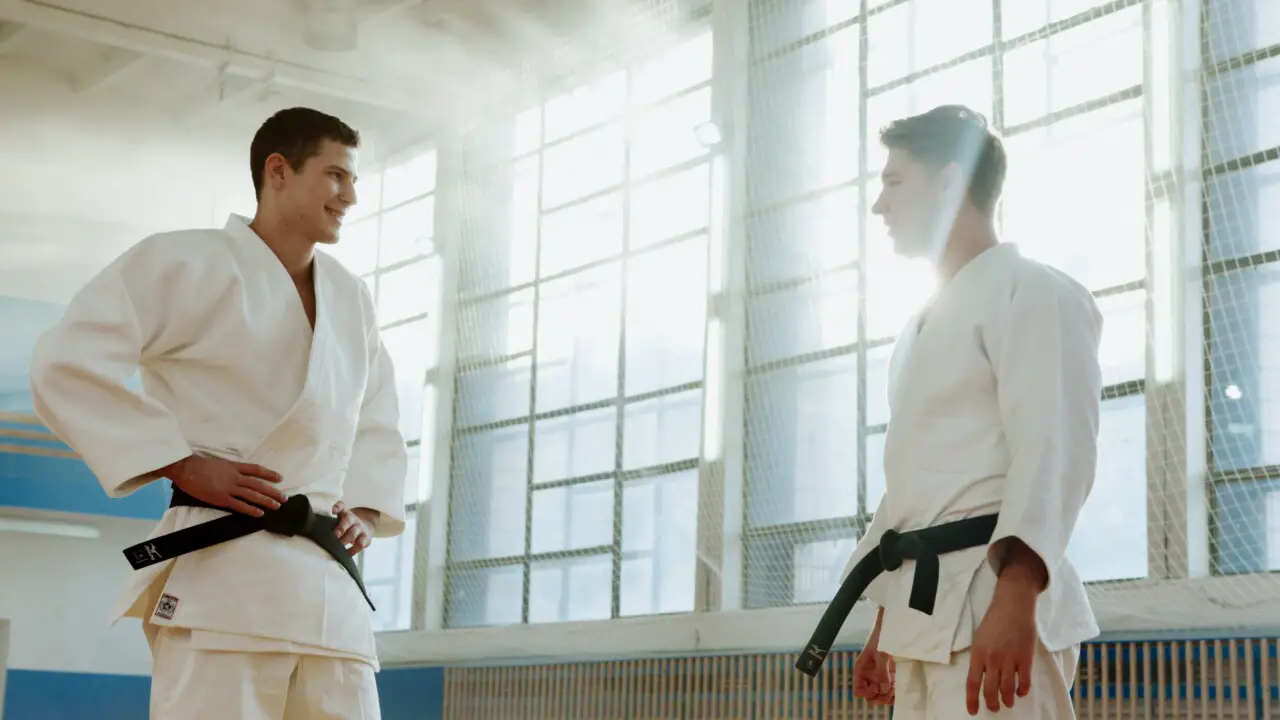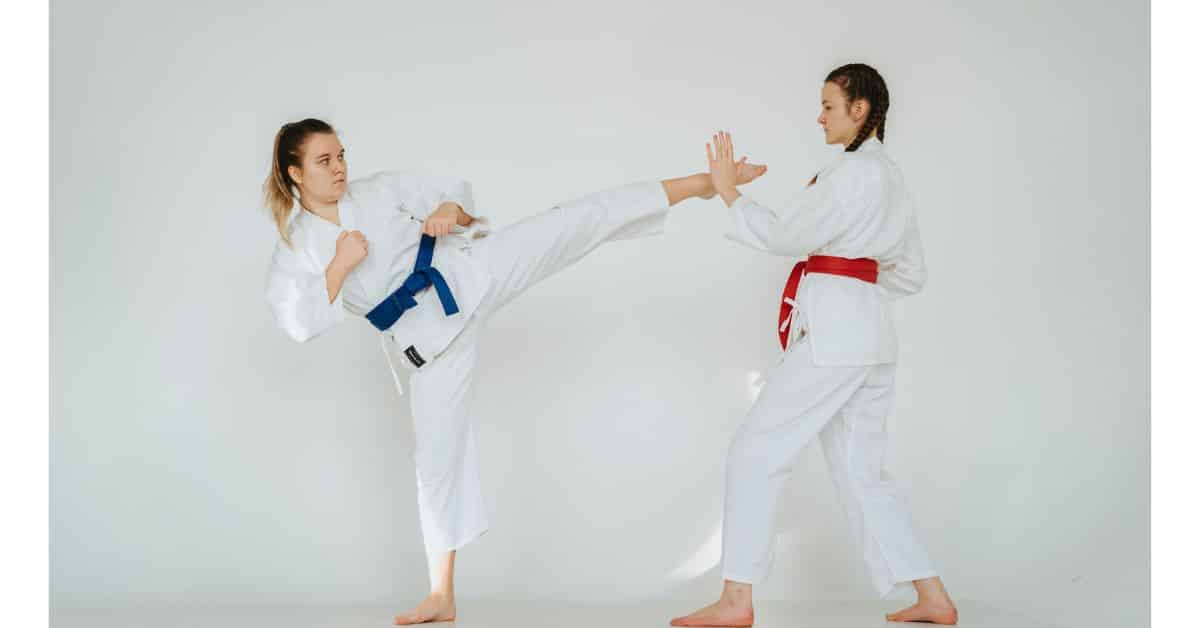Have you ever wondered what the colored belts mean in Karate? Today, while some martial arts include a belt ranking system, some don’t. For that reason, you may get confused when discussing the different colors and their meaning.
Karate is a prevalent martial art that uses a belt system to rank its trainees. As a result, you may become confused when looking at the different colors and stripes some trainees’ belts include.
So, let’s examine the Karate belt order and its meaning.
- White
- Yellow
- Orange
- Green
- Blue
- Brown
- Black
Currently, these colors may not ring a bell or activate any emotion. However, after reading this article, you’ll understand where they come from and what they represent. Then, you’ll learn to identify and appreciate the ranking system.
Nonetheless, it gets more complicated.
Once you reach the black belt, you’ll start your second Karate journey: Dan ranks.
Dan ranks are the progression system after you reach the black belt. In it, you’ll see many odd names, such as Shodan and Nidan. Yet, we’ll examine them in the 2nd part of this article.
Here’s the Karate Dan belt order:
- Shodan
- Nidan
- Sandan
- Yondan
- Godan
- Rokudan
- Nanadan
- Hachidan
- Kyudan
- Jūdan
So now, let’s dive into the Karate belt order. First, we’ll learn about the different colors, order, meaning, and history. Then, as a result, you’ll learn to appreciate and understand what these random colors mean and represent.
Karate Belt Order
This article is divided into 2-parts. First, I’ll begin by examining the Kyu (student) belts. Then, I’ll explain the Dan belts you receive after your black belt.
The following table demonstrates the average amount of time it takes to earn each belt.
| Belt Color | Time to Achieve (years) |
|---|---|
| White | 0 |
| Yellow | 0.3-1 |
| Orange | 0.5-2 |
| Green | 2-4 |
| Blue | 3-6 |
| Brown | 4-8 |
| Black | 5-12 |
Before we dive in, let’s understand how these belts first came to life.
A brief explanation of Karate belts
If you scroll down this article, you’ll notice that there are many colors and sub-divisions that you can achieve. As a result, you may think this is how it has always been. However, such a statement isn’t as accurate as most people think.
First, there were 2-belts: black and white. White represented students and black senseis (instructors). However, with time, trainees understood that they needed more belt colors to represent more skill levels since an outsider may think all the students are at a similar skill level.
As such, once 2-students fight, you’ll expect it to be close. Nevertheless, it more often than not wasn’t.
As such, with time, more and more colors and ranks entered the order. So now, we’re left with many colors and ranks- each representing a different rank and skill level.
Kyu belts (Student Levels)
The first part of this article will discuss the student levels. These belt colors may seem like they’re easy to achieve. Yet, that can’t be further from the truth.
Progressing through the ranks- is demanding physically and mentally. As a result, only those who dedicate their time and effort can attain the next rank.
Nonetheless, I still see an expectation of progressing through the ranks and learning to fight while not investing any effort.
You’re at a dead end if you think you can advance through the ranks without sacrificing your time and effort. But, on the other hand, if you know what you’re in for and are eager to learn and practice, you’ll skyrocket your progression and advance faster.
Next, we’ll go over the first belt: white.
White belt
The white belt was the first belt color every Karate practitioner had had his hands on.
While some schools treat it as if the trainee is unranked, others symbolize white with a fresh start.
As a result, some may call you an unranked and others a novice. But, eventually, if you’re eager to learn, you’ll progress to the next belt in no time.
Many Karate trainees will remain a white belt for their entire lives, as they don’t want to progress and reap the many benefits that Karate offers. As a result, they won’t reach the point that they progress to the next belt. However, you don’t have to be one of them.

If you want to set yourself up for success, I encourage you to read an article I wrote on tips for martial arts white belts. It’ll ensure you’ll reach the next belt faster and more efficiently.
Yellow belt
Once you prove to your sensei or instructor that you deserve to progress to the next rank, you’ll attain the 2nd belt: the yellow belt.
As I previously mentioned, most people will never reach the yellow belt, as it requires plenty of dedication and consistency.
That said, following a few principles will lead you to success. Essentially, you can’t expect to progress through the belts if you’re not eager to learn more.
However, if you feel that passion inside of you for learning and practicing, I have no doubts, you’ll attain the yellow belt.

The last advice I want to give is: don’t feel bad for being a yellow belt.
Yes, the journey has only just begun. However, don’t feel discouraged. Instead, focus on the bright side; you already did what most people can’t do, be consistent enough to attain the 2nd belt.
The yellow belt symbolizes the sun, which people interpret in different ways. However, a common interpretation is once you reach the yellow belt, the sun shines as if you’ve passed the first test.
Most people quit before they even really try. As a result, they’ll never reap the many benefits Karate offers. However, you will if you keep dedicating yourself to the fighting style.
Orange belt
So far, your journey has been tough. Consequently, you may feel discouraged but still eager to learn about martial arts.
Well, now comes a particular time in every practitioner’s fighting journey. Now, you attain the 3rd belt, the orange belt.
The orange belt is the 3rd belt in the Karate belt system. Most trainees will never reach this rank because it takes more time than the 2nd one, which makes sense.
Nonetheless, some may feel unwilling to invest their time and effort into martial arts. However, you did, and now you proudly wear the orange belt.
The orange color means light. Throughout history, Karate trainees who attained this belt reported feeling more fulfilled and happier. Therefore, it is no surprise that medical studies proved that Karate improves self-esteem and mental health.

If you stay consistent enough, you’ll go through more training sessions and learn more about the martial art, which is an essential part.
So now, you attained the following belt.
Green belt
Congratulations! Your sensei is highly impressed by your skills and progression rate. Consequently, he granted you the 4th Karate belt: the green belt.
Here comes the fun part. You now know to fight appropriately and beat most non-martial arts trainees in a fight. You learned to punch, kick, and grapple. Thus you’re a dynamic and capable fighter.
The green color symbolizes growth from the ground to the surface.

When you were a white belt, you first began your journey. You didn’t know how to throw a proper punch.
With time, you learned the basics and attained the yellow belt. This is when you can throw a few hits, but it’s not there yet.
Then, you got the orange belt, symbolizing understanding and spurs of growth.
Now, however, you attained the 4th belt, which means you’re a fighter. You know how to force an opponent to submit by executing a grappling movement and how to throw a fierce body kick.
With time, you’ll begin to combine many techniques by yourself to create incredible achievements and combos. But, eventually, these are the hits that cause the most damage.
Blue belt
The 5th belt is the blue belt. Those who achieved it are incredible fighters.
Nonetheless, few are the people who progressed this far into their training to attain this belt.
It is no secret that most people will fail before they achieve the yellow one. So, when talking about the blue belt, the 5th one, we’re discussing years of experience.
The meaning of the blue belt is growth from the surface to the sky. While the green belt symbolizes growth from the ground to the surface, blue refers- from the surface to the sky.
Which is more distance, ground to surface or surface to the sky? The answer is clear; of course, from the surface to the sky is more distant. So, what do we understand from that?

Once Karate trainees reach the blue belt, they can throw combos and involve every aspect of their training.
Therefore, they’re more effective, unique, dynamic, and unexpected. Indeed, at this point, you’re an incredible fighter who can reach for the sky.
Brown belt
Next is the 6th belt: the brown belt. Again, if you’re familiar with the basics of Karate belt colors, you likely know the brown belt.
The brown color symbolizes combinations and unity. That’s because once trainees attain the brown belt, they can combine everything they learned to cause massive damage to their opponents. Eventually, combos are what make Karate as effective as it is.

If you look at all the other martial arts, they combine many techniques to create a more dynamic style.
The best example of this is MMA or mixed martial arts. MMA is the most dynamic martial art since it combines many techniques, like grappling and punching.
Karate is no different. In fact, the best fighters are the ones that can utilize many worlds to form an ultimate skill set.
To summarize, brown represents unity. As such, the trainees who attain it can use everything they learned and combine it to become incredible fighters and performers.
Black belt
Now, you’re a brown belt, and you’ve been staying consistent with the desire to reach the last Kyu Karate belt, the black belt.
However, things have been rough. First, you must pass a test in front of numerous Karate masters. The test includes exercises such as sparring, performing, and showcasing your skills. Because of that, attaining it- takes longer than usual.
Yet, you passed the test and can now call yourself a black belt in Karate.
To many of us, this is the end goal. The black belt symbolizes dedication, hard work, and character. If you did it, you could be proud of yourself, as few are people who attained it in the history of martial arts.
The black color symbolizes the night and darkness. You now have finished your first part of Karate training, which is learning. Now, the sun will soon rise, and the dawn will bring the desire to continue training and mastering Karate.

Now that you’re a black belt, you haven’t mastered Karate. So it’s time to continue training and show your skills to the entire world.
Some people refer to the black belt as the second white belt; as you’re about to enter a new world of Karate, you’re a white belt for them.
Dan ranks
You’re now a black belt, congratulations. As I previously mentioned, the black symbolizes night, hence a new beginning. As such, you’re about to enter a new ranking system, which doesn’t include colors.
Mostly, Dan ranks won’t include the use of colors. However, high Dan ranks will wear a mix of red/blue with black in some cases and some martial arts. That indicates their level of proficiency and contribution to the martial arts community.
Now, let’s dive deeper into the world of Dan ranks
The following list is the order of the Dan ranks.
- Shodan
- Nidan
- Sandan
- Yondan
- Godan
- Rokudan
- Nanadan
- Hachidan
- Kyudan
- Jūdan
I know the names are odd. Yet, bare with me. I’ll go over the different ranks, so we will all understand their meaning and what they represent.
Shodan (1st Dan)
The first Dan rank is Sodan. Those who reached it know Karate’s fundamentals and can use them.
Nidan (2nd Dan)
The second Dan rank is Nidan. Trainees who attained it know the fundamentals of Karate and are capable of causing massive damage with it.
Sandan (3rd Dan)
The third Dan rank is Sandan. Those who reached it have mastered the fundamentals of Karate and can use them to beat any opponent swiftly.

Yondan (4th Dan)
The fourth Dan rank is Yondan. Those who dedicate their lives and effort to martial arts eventually reach it.
Godan (5th Dan)
The fifth Dan rank is Godan. Karate practitioners who attain it are masters of the art and have a much deeper understanding. They can use all the techniques much more efficiently than 99.9% of Karate practitioners.
Rokudan (6th Dan)
The sixth Dan rank is Rokudan. Those who reached it are masters of the fundamentals of Karate and can use it to beat opponents extremely fast. Only true martial artists who dedicated their lives and soul to Karate will reach 6th rank.
Nanadan (7th Dan)
The seventh Dan rank is Nanadan. From now on, the progression rate is less about your individual skill since everyone understands that you’re an incredible fighter.
Rather, it’s more about your leadership and contribution to the martial art. So, for example, those who teach Karate are more likely to attain it.
Hachidan (8th Dan)
The eighth Dan rank is Hachidan. Those who reached it have mastered the art of Karate. Their understanding of it- is profound.
Moreover, they largely contributed to the Karate community. Consequently, they’ve influenced many’s lives, representing their community contribution.
Kudan (9th Dan)
The ninth Dan rank is Kudan. Those who reach it have mastered Karate and contributed plenty to the community. As a result, they deserved their promotion.
Jūdan (10th Dan)
The last Dan rank is Jūdan. Those who reached it are the best among the best. The masters dedicated their lives to learning the depths of Karate. Additionally, they instructed, led, and performed to benefit the martial arts community.
Eventually, those who reach it deserve to enter the hall of fame of Karate masters. In fact, you’ll be surprised when you hear the number of people who reached such a level. The number is 15.
Yes, 15-people have reached the rank of 10th Dan. Now you may grasp how much you need to invest to achieve such a level.
Kids Karate Belt Order
Kids under a certain age have a different belt order because they haven’t started their real journey yet.
Karate children’s classes don’t teach Karate moves that adults learn. Instead, the coaches teach them discipline and consistency. Later in life, being consistent and dedicated- is more beneficial than knowing to fight.
So, here is the Karate belt order for kids:
- Gold
- Green
- Purple
- Blue
- Red
- Brown
- Black
While kids’ belt sequences are Gold, Green, Purple, Blue, Red, Brown, and Black, they can also attain stripes for their current belts. As a result, before a child trainee can progress from gold to green, he may need to earn 1-3 stripes on his existing belt.
Final words
To end this article, I decided to tell my story about martial arts.
Martial arts have given me the opportunity to increase my personal growth exponentially. Because of that, I can’t be more grateful for what I have achieved and for the person I am today.
I’m confident you’ll be able to go through the same change, which only requires will power and willingness to change. If you want to improve yourself deep down, you’ll do anything it takes to see positive results.
The last advice I’ll leave is to start as soon as possible. I know it may seem like you’re incapable of going through this transformative journey. However, I assure you that you’ll go through a similar change. Eventually, Karate gives you the platform to go through self-improvement, which will drastically improve your life.

